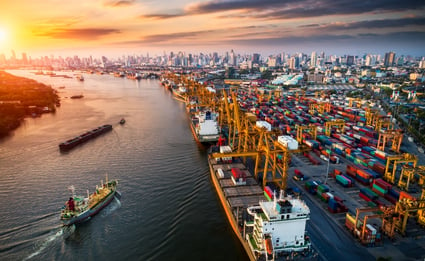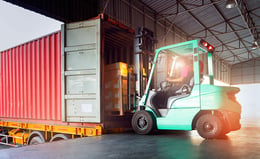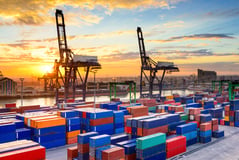5 Tips to Fight the Tender Rejection Rate
Martin Pahulje - February 09, 2021

It’s been a rough 12 months thus far, and tender rejections are on the rise. It’s not too surprising as to why. The shipping industry has seen more goods than ever passing through the various supply chain channels, and 3PLs, shippers, and others have found themselves in a position where they can be selective about what freight they actually want to take on. This puts companies who are slow to reserve capacity, or are trying to ship to new markets, at a disadvantage. They are looking to optimize their logistics costs and ride out the storm, but are finding that they are up against increased competition and have no choice but to spend heavily for premium freight on shipments that would have been tendered successfully in previous years. This is a process that can’t sustain itself for too much longer.
The challenge is this: when you request a tender from various carriers, their quoted prices are based on the information they have on hand at that time. No one can predict the future or accurately know if fuel prices are going to rise or fall, or if demand will outpace supply, but they look to historical data and market conditions as a benchmark for their quote. For a company, it’s about more than just cost - it’s also about finding a tender that will meet your unique needs and plans for growth, expansion, or exploring new modes and processes. Carriers, in turn, want to secure a medium or long term commitment to volume, but won’t hesitate to reject a tender if it’s not going to be good for their bottom line.
Luckily, there are ways to fight the rejection rate and put your freight at the top of the pile.
Why Are Tenders Rejected?
Trucking, like anything else, is subject to supply and demand. The supply is the number of fleets and trucks in the market, while demand is the volume of things being shipped. Rates, either spot or contract, are determined based on these factors.
For example, when demand rises via growing truckload volumes, more often than not it meets an impasse. In most cases, the number of trucks in the market doesn’t rise proportionately to demand, thus rates begin to rise to a premium to compensate for the lack of capacity. On the other side of the equation, if truckload volumes begin to decrease, but the supply of trucks in the market does not fall in proportion, then generally, rates begin to fall. This balance of cause and effect between supply and demand is what determines a carrier's willingness to accept a tender or not.
To determine the capacity of the trucking industry and predict a rise or fall in rates, the key metric to look at is the Tender Rejection Rate (TRR). This is a measurement of carriers’ willingness to accept or reject the loads that are tendered to them by shippers. This is determined as a percentage of loads rejected to total loads tendered: i.e. if a carrier rejects 2 of the 4 loads tendered, then their TRR would be 50%. This is viewed as an indicator of carrier activity and market capacity. The higher the TRR, the less availability the carrier has to move the freight at the contracted rate in the market.
There are two primary reasons why carriers will increase the rate at which they reject tenders:
- They may literally be at full utilization and not have any excess capacity to take on the load.
- Carriers may reject the load if they have too low of a rate with you, and more attractive alternatives in the form of higher rates in the spot market, or from another broker or shipper. The length of haul and opportunities (or lack thereof) of backhauls can also play a role.
Mitigating the Rejection
In the US, given the events of the past year, the current national tender rejection rate stands at nearly 18%, 3x the higher than the rate was a year ago. With the market so tight, shippers need to find ways to fight back against the tender rejection rate and get their cargo delivered.
1. Know Exactly What You Need, But Adapt When Necessary
Before we dive into the bigger solutions, it would be wise to dive deeper into one of the more basic reasons that your tender is rejected and how to deal with it.
The first reason we outlined above had to do with overall capacity and the lack of availability. This can be more complex than just saying there aren’t enough trucks and trailers to transport your freight. In fact, it could be that there aren’t enough of the right kind of trailers. This is a common reason that tends to over-index when it comes to tender rejection - the type of trailer required. Different types of freight require specialized trailer usage, whether it’s a climate-controlled reefer, a dry van, or a particular type of flatbed such as a conestoga, side kit, etc... A change in the capacity of any of these, will impact how often your carrier will reject your cargo.
You may have always relied on a particular trailer type to get your freight from Point A to Point B, but now, they’re no longer available. This means you might have to reassess how you put together your loads. If enclosed trailers are the most popular form of capacity, and you don’t have access any longer, is there a way to adapt to a flatbed or a conestoga, with additional weather/damage protection implemented on your freight? It’s worth a thought.
Simply put, if you keep on encountering the same disruption between your needs and the carrier’s infrastructure and capacity, re-evaluating some logistical issues on your end should be at least considered. Showing that you’re willing to work with your carrier, and possibly negotiating a mutually beneficial spot rate, can go a long way to reducing your rejection rate.
2. Invest in Transportation Forecasting
Now, more than ever, investing in a transportation forecasting solution is crucial. This technology can help shippers forecast incoming orders and future freight prices and capacities via machine learning- and AI-powered predictive capabilities. The right solution can develop lane- and mode-specific shipping-demand projections to help you submit a tender too good to pass up, well before your competitors.
Currently, the transportation environment is unfavourable to the traditional way of doing things, especially for manufacturers of large goods such as automobiles and appliances. This is so, due to the way current transportation management software works. You need to have real orders coming in before you can book freight, which constrains a shipper to the traditional booking window of 1-2 days after an order comes in. This leaves you with a booking window so narrow, that you’re stuck with whatever options are available at the time, and most often than not, those options aren’t appropriate for their freight. The best option would be to break out of that 1-2 day cycle with a transportation forecasting solution, that can help you book your transportation with an intelligent forecast.
By analyzing the current conditions, upcoming market trends, and changes in capacity, you can estimate the optimal moment to secure the capacity, well ahead of the competition, guaranteeing that bankable revenue for your transportation and logistics partner. The current market offers TMS solutions without this sort of functionality, but as time goes on, it will be the only solution to remain agile in a competitive marketplace.
Given how challenging it’s been to secure favorable cargo rates in the current supply chain, turning to this technology will have a transformative effect on reducing your rejection rate.
3. Turn to Integrated Supply Chain Planning
The kinds of predictive potential that we’re talking about in the point above offer several other benefits as well, such as cost optimization opportunities and increased agility. In an era of market volatility, supply chain disruption, and global pandemics, agility is your greatest weapon against tender rejection.
Consider this: earlier we indicated how relying on a traditional TMS solution, where you wait for your real orders to come in before you book freight, leaves you a 1-2 day booking window to secure your transportation. At that point, you can only take what’s available, and more often than not, will be an unfavourable option. A robust forecasting solution, however, will take you out of that 1-2 day booking window and help you avoid premium prices and potential late deliveries due to too much competition for existing capacity, and will lengthen your transportation planning window. If you start applying these same workflows across your entire planning chain, you’ll create a more cohesive process that unifies your strategic, operational, and tactical planning to increase your agility. For example, bringing an order forecasting solution into your S&OP process can help you optimize and secure not only your freight solutions, but your production capacity as well. By aligning and integrating your production and logistics planning, you can potentially discover new efficiencies and rely on your newfound agility to help mitigate any pushback on your tender.
4. Lean in on Digitization
Currently, most supply chain businesses rely on historical order data to predict upcoming volume. But this outdated modality of thinking is the fastest way to disruption. Contrary to that old adage about not learning history and being destined to repeat it, the idea is knowing your historical data, so you don’t do it again. Your past order volume can be informative, yes, but should be taken with a grain of salt as global supply chains change and evolve. What you need is to rely on advanced analytics and a connected environment to be proactive about your planning.
To accurately predict the future of your supply chain and your shipping requirements, you’ll need data—a lot of it. And tenders come with a lot of information with a relatively short turnaround time. This isn’t a time for a manual process—scribbled notes, frantic phone calls, and spreadsheets. The sheer volume of information you’ll need is more than a human tender manager can possibly hope to retain, and the risk of error is too high to fathom. Instead, you’ll need to connect a large number of data sources across your value chain, to gain that insight. The tender management system that you use should be a part of a highly interconnected digital environment that has insight into your order management system, your warehouses, factory floor IoT devices, and even your suppliers/carriers IT environments. With all of these data sources pooling together, you can figure out how much capacity you’ll need to acquire, which carrier options are the best fit, and any other logistical hurdles that stand in the way of getting your tender and freight procured.
5. Move Towards Tender Management 4.0
They say that the best defence is a good offence. The same goes for mitigating any problems with your tender. We’re on the cusp of the Industry 4.0 era, and the tools that can forecast future demand are available, and uncanny in their abilities to manage your transportation needs with accuracy. As time passes, these software solutions will become more and more intuitive via AI and machine learning, automating your tender management solution and making it smarter and more connected.
The best solution would be something that could:
- Aggregate any and all data available regarding haulers, other partners, route information, carrying capacity, as well as any tariffs and other cost considerations.
- Offer visualized statistics regarding carriers, capacity fluctuations, and pricing seasonality.
- Generate your tender documents
- Integrate into your supply chain planning processes and freight exchange platforms.
This solution would make all the pertinent information easy to track and manage, and it would generate visual examples, even as the market conditions change and evolve. This enables you to align your strategy with the available choices and adjust on the fly, to ensure that your decisions are optimized, dynamic, and done in real-time.
This puts you and your freight ahead of the competition and enables you to address objections before they occur. Having the right tools, and additional tools to support those tools, can help you with your supply chain integration, your IoT integration/infrastructure, and your real-time data management. Tender rejection causes more frustration and delays than it’s worth, and it would behoove your organization to look at integrating its supply chain with smart solutions.
If you want to learn more get your Guide to Logistics 4.0
In this Guide you will learn:
-
Why a strategic process in transportation planning is a top priority for digitalization
-
What megatrends will increase supply chain volatility
-
How to manage it
LATEST POSTS
- Understand Circular Economy in The Manufacturing Industry
- How Can Industry 4.0 IT Integration Be Achieved Smoothly?
- The Significance of Order Sequencing in Discrete Manufacturing
- How to improve your Supply Chain Management: The Power of Control Towers
- Optimizing Human Resource Scheduling in Manufacturing: A Technological Approach



